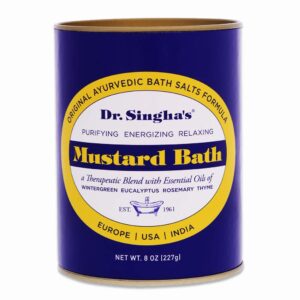A fever can actually benefit a sick person, and both traditional healthcare practitioners and now even modern researchers have attributed tendencies to over-treat to “fever phobia”–a fear that fever is harmful, which likely originated after the introduction of anti-fever drugs like Tylenol.
Fever is a protective adaptive response that should be allowed to run its course under most circumstances. This approach has been supported by several recent randomized controlled trials.1

Elevated body temperature sets in motion a series of mechanisms that regulate our immune system. A fever serves to protect your body against infection in four major ways:
- Fever stimulates white blood cells and other “fighter” cells to fight and destroy viruses and bacteria, other pathogens, and even cancer cells. An elevated body temperature triggers cellular mechanisms that ensure the immune system takes appropriate action against the offending virus. For example, fever stimulates an increased production of interferon, a chemical that inhibits viral replication and signals our antibody response as well. This is what attributes to the feeling of achiness.
- Fever reduces the growth of viral replication, even killing viruses and bacteria directly. The higher your core body temperature is, the harder it is for harmful microorganisms to survive in your body.
- A fever helps to shuttle iron to your liver so that it is not readily available to fuel the growth of invading pathogens.
- Fever promotes detoxification through the skin, kidneys, liver, and bowels.
By artificially lowering fever with Tylenol or aspirin, infection can multiply and spread to internal organs. “The high case-fatality rate—especially among young adults—during the 1918–1919 influenza pandemic is incompletely understood. Although late deaths showed bacterial pneumonia, early deaths exhibited extremely “wet,” sometimes hemorrhagic lungs. The hypothesis presented herein is that aspirin contributed to the incidence and severity of viral pathology, bacterial infection, and death, because physicians of the day were unaware that the regimens (8.0–31.2 g per day) produce levels associated with hyperventilation and pulmonary edema in 33% and 3% of recipients, respectively. More recently, pulmonary edema was found at autopsy in 46% of 26 salicylate-intoxicated adults.”2
From the 1950s to the 1980s, thousands of deaths among children following influenza and other infections (eg, Reye syndrome) were unexplained until studies identified aspirin as the major contributor,3-5 and aspirin label warnings were followed by a disappearance of the condition.6
In a randomized control trial seeking to evaluate the impact of antipyretic therapy on outcomes in critically ill patients, aggressively treating fever in these patients led to an increase in mortality. Patients were randomized to an aggressive treatment group, consisting of acetaminophen 650 mg every 6 hours for fever >38.5 °C with addition of a cooling blanket for temperature of >39.5 °C, or a permissive group where treatment was initiated at a temperature of >40 °C with acetaminophen and cooling blankets. The study had to be terminated at the interim analysis as there were seven deaths in the aggressive group and only one death in the permissive group. 7
The great Physiomedicalist Thomas Thurston said this in 1867, “Of all the symptoms of acute infectious diseases, fever is the most constant, yet of the manner of its production, and its influence upon the course of these diseases, we are almost wholly ignorant. At the present time, the immediate practical importance of this question is very great, since so large a part of the treatment of these diseases consists in combating the fever, which is so constantly present. The fallacy of such treatment is apparent, if in fever we have one of the salutary influences which bring about the natural recovery from these diseases.” A fever is a response of the Vital force to a pathogenic invasion, not the pathogen itself. “The living organism is essentially a vital realm dominated by Vital force, an energy inherent in the nuclear mass of bioplasm (protoplasm), or living matter of tissue-units. All functional operations of the organism, in health or disease, are the aggregate expression of Vital action in the living matter of tissue-units. This Vital force, manifest only through bioplasm, or living matter, is endowed with integrating and definite developmental instincts, and from the basic germ builds up the organism, and maintains its functional integrity. Vital force, through living matter, is always resistive, eliminative, and reconstructive, in intent and purpose, when the vital domain is invaded by inimical substances, forces, or influences.”8

Researchers have found that small increases in body temperature can speed up the body’s process for preventing and responding to infections. In fact, the hotter our body temperature, the more our bodies speed up a key defense system that fights against tumors, wounds or infections.9 Scientists have also discovered that when body temperature drops, the biological anti-infection process starts to slow down.
The classic experiment by Kluger et al. in 1981 was done on cold-blooded iguanas that were infected with bacteria. Kluger gave them the opportunity to seek heat via sunlamps and all but one sought the warmth to raise their temperature. The one who did not was the only one who died. Next, he injected the iguanas with bacteria and gave them antipyretics (a type of drug to reduce fever such as aspirin, NSAIDs, etc.). The iguanas that were able to mount a fever despite the antipyretic were the only ones that survived.1
Why do viruses infect people and spread quicker in winter?
We have known for some time that influenza and cold epidemics tend to be worse in the winter when temperatures are cooler. Sunlight, heat and being outdoors are two things people get more of in the summer. Sunlight, provides vitamin D, and like zinc, is essential for a healthy immune system. Indoor air allows viruses to concentrate more, whereas the outdoors quickly disperses viral particles. 10
Keeping windows open, fans running, and essential oil diffusors going are all good things to do to reduce viral invasion.
Does fever cause brain damage?
A fever cannot cause brain damage unless it reaches 107.6 degrees Fahrenheit (42 degrees Celsius) and stays there for an extended period of time. Since your brain has a built-in thermostat that does not allow your core temperature to rise above 106 degrees Fahrenheit (41.1 C) during an infectious process, it is virtually impossible to experience brain damage from a fever caused by a bacterial or viral infection. In addition, when managing a fever it is important to always keep the head cool, thereby encouraging heat to disperse more evenly throughout the body.
Understanding and Managing A Fever
For each degree the temperature increases, the pulse should increase 10 bpm; if less than 10, a deficient fever is present and requires more warming and stimulating herbs. For a deficient fever, circulatory agents such as prickly ash bark or cayenne (in tiny amounts) should be given, along with diaphoretics (see below) to induce sweating. I always tell people when ill with an acute infection and fever to get sweating, heat the feet, or even the entire body if you are cold, keep hydrated and cool the head with a damp washcloth. I encourage people to support the body in working with the fever rather than attempting to artificially suppress it, which is counterproductive to healing.I often recommend mustard foot baths or mustard baths with Epsom salts and essential oils along with a cup of diaphoretic tea (ie; peppermint or ginger), either prior to or during a hot bath, immediately followed by wrapping up, getting into bed and sweating. Many people often feel better by the next day if they’ve responded swiftly at the early onset of a fever.
The class of herbs most often used to assist healing when one has a fever are referred to as diaphoretics. They enter the circulatory system, and as they are eliminated by the sudoriferous glands, they stimulate the local nerve-fibers, stimulating these glands to increased action. Herbs characterizing this action are boneset, yarrow, peppermint, ginger, linden, elder flower, and jaborandi, to name a few. These herbs do not directly lower temperature, but instead activate perspiration and help move the heat outward, which is the best way to work with a fever to support the body in warding off an infection. Stimulating, rather than relaxing diaphoretics, should be utilized for deficient fevers as mentioned above. For example, ginger is a great stimulating diaphoretic, while peppermint is more of a relaxing/cooling diaphoretic.
Mustard Foot Baths

A recent study (103 participants) was conducted to evaluate whether mustard foot baths improve the symptoms of patients with respiratory tract infections (RTI). The conclusion of the study could provide a first insight into a possible strategy to improve symptoms regarding RTI by using mustard seed foot baths.11 A hot mustard seed foot bath consists of a foot bath at 40° C to which three tablespoons of ground black mustard seeds have been added and stirred. The footbath must come above the ankle joints. It is applied for 7 minutes.
I typically recommend full body mustard baths, using 1-3 tablespoons of mustard seed powder such as Dr. Singha’s Mustard Bath, which includes aromatic essential oils, together with 1 cup of Epsom salts, 1 tablespoon of baking soda. The Epsom salts (magnesium sulfate) and the baking soda (sodium bicarbonate) can really help relieve the bone and muscle achiness.
Healing with Herbal Medicine
In closing, let us remember that healing with medicinal plants is as old as humankind itself. Plants respond to viruses using elaborate networks of genetic interactions. Plants also induce hypersensitive and systemic acquired resistance responses, which together, limit the virus to infected cells and impart resistance to the noninfected tissues.12
References:
- Juliet J. Ray and Carl I. Schulman. Fever: suppress or let it ride?, J Thorac Dis. 2015 Dec; 7(12): E633–E636. doi: 10.3978/j.issn.2072-1439.2015.12.28
- Starko KM. Salicylates and pandemic influenza mortality, 1918–1919 pharmacology, pathology, and historic evidence. Clinical Infectious Diseases. 15 November 2009;49(9):1405-1410. https://academic.oup.com/cid/article/49/9/1405/301441.
- Starko KM, Ray GC, Dominguez LB, Stromberg WL, Woodall DF., Reye’s syndrome and salicylate use. Pediatrics 1980;66:859-64.
- Waldman RJ, Hall WN, McGee H, Van Amburg G. Aspirin as a risk factor in Reye’s syndrome. JAMA 1982;247:3089-94.
- Halpin TJ, Holtzhauer FJ, Campbell RJ, et al. Reye’s syndrome and medication use. JAMA 1982;248:687-91.
- Belay ED, Bresee JS, Holman RC, Khan AS, Shahriari A, Schonberger LB. Reye’s syndrome in the United States from 1981 through 1997. N Engl J Med1999;340:1377-82.
- Schulman CI, Namias N, Doherty J, Manning RJ, Li P, Elhaddad A, Lasko D, Amortegui J, Dy CJ, Dlugasch L, Baracco G, Cohn SM., The effect of antipyretic therapy upon outcomes in critically ill patients: a randomized, prospective study. Surg Infect (Larchmt). 2005 Winter; 6(4):369-75.
- Thurston, J. M., M.D. The Philosophy of Physiomedicalism: its theorem, corollary, and laws of application for the cure of disease (1900), pg 17., RICHMOND, INDIANA NICHOLSON PRINTING & MFG. CO.
- C. V. Harper, D. J. Woodcock, C. Lam, M. Garcia-Albornoz, A. Adamson, L. Ashall, W. Rowe, P. Downton, L. Schmidt, S. West, D. G. Spiller, D. A. Rand, M. R. H. White. Temperature regulates NF-κB dynamics and function through timing of A20 transcription. Proceedings of the National Academy of Sciences, 2018; 201803609 DOI: 10.1073/pnas.1803609115.
- Lowen, A.C., S. Mubareka, J. Steel, and P. Palese. 2007. Influenza Virus Transmission Is Dependent on Relative Humidity and Temperature. PLOS Pathogens. 3(10):e151.
- Katja Goetz ,1 Aune Hinz,1,2 Jost Steinh¨auser,1 and Ulrich von Rath, Use of Mustard Seed Footbaths for Respiratory Tract Infections: A Pilot Study, Hindawi Evidence-Based Complementary and Alternative Medicine Volume 2020, Article ID 5648560, 6 pages, https://doi.org/10.1155/2020/5648560.
- Kranthi K. Mandadi and Karen-Beth G. Scholthof, Plant Immune Responses Against Viruses: How Does a Virus Cause Disease?, The Plant Cell May 2013, 25 (5) 1489-1505; DOI: https://doi.org/10.1105/tpc.113.111658.


I’m surprised there haven’t been comments to this blog. I, like most everyone else, has been led to view fever as the enemy. I found the information contained herein to be an eye opener. From now going forward I will consider fever an ally to be worked with, not suppressed. Thanks Donnie!
Again, such wonderful information. When my sister got her BSN, she did a research paper on fever, and was shocked to find that there was so MUCH scientific evidence at odds with current medical practice of liberal use of anti-pyretics. I wish someone would note how many people with complications from illness used antipyretics at the onset of their symptoms. It might save lives.
Thank you so much for addressing the need for fever in healing! When my children were just babes and toddlers in the 80’s I had the blessing of a wonderful Health Clinic (that means HEALTH) nearby with very well trained, read and experienced Naturopaths. Maybe you’ve heard of it? The Clymer Health Clinic. Anyway, when my children had a fever, I put them in a hot bath – as hot as they could stand until they began to sweat. Then we wrapped them in a towel and blankets until they sweat the fever out. If not for my naturopathic doctor, I wouldn’t have known. I’ve just discovered your website, thanks to my dear sister-in-law. I’m so grateful to have been introduced by her.